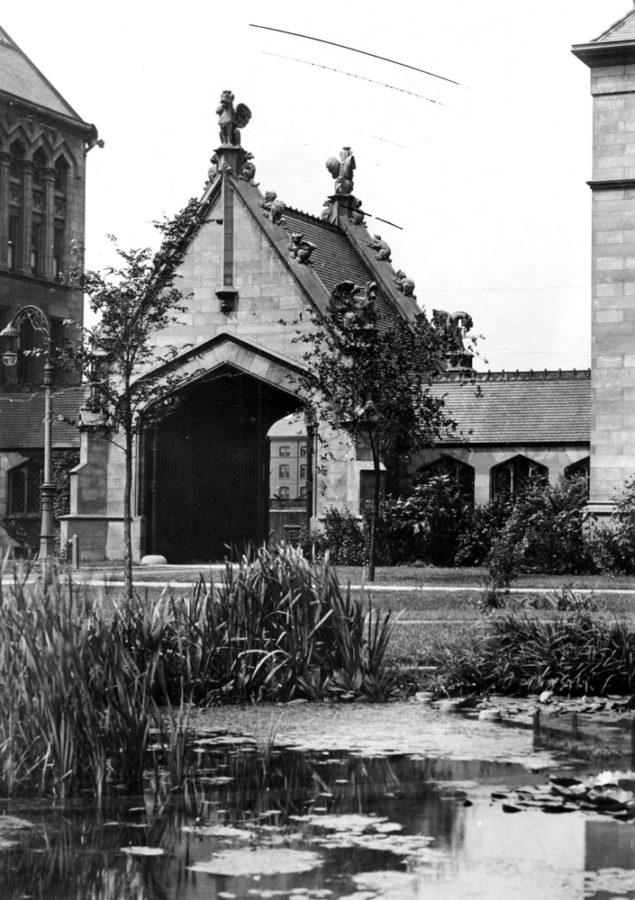The walls have voices at 56th and Lake Park. “Well, it was here before, it was here after, and it’s going on,” they say (“it” presumably referring to the city, life, any number of institutions). “I see a lot of racism…we are all human beings so it shouldn’t really matter, but you can’t tell some of the people that.” Other statements on the wall are a little more existentially uncertain: “I don’t know where I’m going,” reads one. “I’m thinking about how to interweave the stories of genesis and evolution,” says another.
These quotes were part of a mural entitled “Where We Come From…Where We’re Going” created by Olivia Gude, a UIC professor who stood outside the 56th Street Metra station and asked passersby that question and then painted the results on the underpass wall.
The mural is an in-your-face reminder that each and every person getting on the train is physically and metaphysically coming from somewhere and is headed somewhere else. Though all these people are tied together by that theme, their experiences are varied, unique, and complex. The experience of seeing these sentiments on the mural strays dangerously close to a standard illustration of the “Teenager Realizes That The Human Experience is a Relatable One” narrative arc (one that I certainly experienced and is significant and important as a realization, but not particularly novel). So let me say that this revelation was complemented by another, less common one: Engagement with this city and the people and struggles in it can be no more complex than just taking a second to notice my surroundings when navigating Hyde Park.
On urbanist Jane Jacobs’s birthday every year, free locally-organized walking tours are led by city residents in order to get people together to explore, talk about, and celebrate their neighborhoods. And, as a walk leader, I was supposed to share my knowledge of my home for the past year—knowledge that I thought I would rediscover and review, but then realized I had never even discovered in the first place.
This realization really hit home in the Metra underpass. In the span of about a block, my group and I explored and discussed three murals: “Childhood is Without Prejudice,” “Pioneer Social Work,” and “Spirit of Hyde Park.” The first is a series of interlocking children’s faces representing the potential unity of all races. The second tells the story of the struggle for suffrage and civil liberties. The last tells the story of racial injustice, segregation, and oppression through scenes including those of police violence and protests. These three illustrations tell varying yet historically and contemporarily pivotal conceptual narratives—and even though a lot of time has passed since the people on the Metra ruminated on their situation and painters put their concerns about the institutional problems in the city of Chicago on the walls, these murals remain potent and relevant, and sparked civic reflection in my group and me.
The strange thing is, two of the murals are about 10 feet from the dorm room in which I sleep, eat, and study every day, yet I’ve never stopped to look at them before. Every day, I pass the wall art and never take a second glance, the scenes just vague geometric colors and shapes in my mind. It’s a pretty classic case of getting used to beauty with a twist—never noticing it was there in the first place.
We were journeying down 57th on our way to the first mural when we noticed that a man was unloading crates of spray-paint cans from his truck in the alleyway between Kimbark and Kenwood. He told us that he was working on a project that depicted the rap group Stony Island to commemorate one of the band members who had passed away in 2009. He explained the quotes on the wall (“Who’s got the nalej (knowledge) eye?” and “minds open,” two particularly famous lyrics from their songs) and talked about the care with which he analyzed the smallest details and spray-painted shadows. He epitomized Jacobs’s model that there is no more impactful way of hearing the story of a community’s history than through the people living it, recording it, and creating it. These people are all around us every day, but their stories and thoughts are also encapsulated by their ubiquitous art, so that engaging in Chicago’s history can be as easy as a Google search and a quick walk down 56th on a Sunday afternoon.
Kiran Misra is a first-year in the College.







